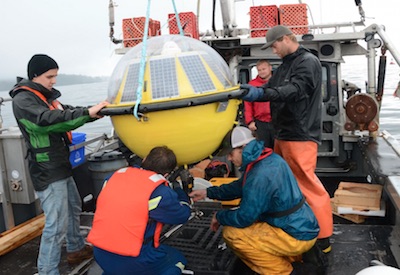Scientists Map BC’s Wave Energy Potential

May 21, 2017
Global wave energy inventories have shown that Vancouver Island’s west coast is one of the most energetic wave climates in the world, and researchers with the University of Victoria’s West Coast Wave Initiative have now mapped the true potential of its wave energy.
Among the findings: integrating a 500 MW wave energy farm could reduce Vancouver Island’s dependency on annual electrical transmission from the Lower Mainland by up to 11%, and reduce peak winter demand by up to 15%.
In response to international attention on Vancouver Island, the West Coast Wave Initiative at the University of Victoria was mandated to develop a “wave-to-wire” numerical modelling effort to understand the feasibility, impacts, and possible structure of future wave energy conversion opportunities in Canada. The resulting report, Wave Energy: A Primer For British Columbia, provides an overview of the spatial and temporal distribution of the gross wave resource, and the methods utilized to characterize the resource. The report presents an objective vision of both the opportunities and challenges for a future wave energy industry in Canada.
Via the gross resource assessment process, researchers have identified multiple locations on Vancouver Island’s west coast that would be suitable for future wave energy development. For example, Amphitrite Bank provides a very attractive opportunity for wave energy conversion with mean energy transport values of 34.5 kW/m only 7 km from shore. This compares favourably against the leading international wave energy development sites in Europe. The wave energy resource varies dramatically over the year.
The greatest challenge to the future development of wave energy is undoubtedly the cost per unit of energy, says the report. Wave energy costs need to be significantly reduced to compete for market share against other renewables. But the scale of the technological challenge is no greater than that which faced wind and solar energy up until the last few years, and both are now enjoying rapid and ongoing cost declines. With similar government support for research and incentives for deployment, there is no reason why wave energy cannot attain similar success. If anything, wave energy may achieve even greater triumphs, given how much more dependable a resource it is.
Policy recommendations made by the report include:
- investigating the international market place for marine energy and determine how BC might leverage its natural competitive advantage, in terms of resource scale and diversity, to be a significant player
- developing the necessary infrastructure to allow BC and Canadian companies to test, operate and maintain WECs and ancillary technologies in BC, rather than losing them to international markets
- developing relevant legislation to support the nascent wave energy industry when it matures to deployment. This includes access to priority locations, streamlining of permitting and co-operation of electrical utilities
- providing seed capital to help develop and manufacture WEC technologies designed for the Canadian wave climate
- continuing financial support for academic research efforts to help better understand and accelerate the pace of development in the marine energy sector
Download Wave Energy: A Primer For British Columbia: http://pics.uvic.ca/sites/default/files/uploads/publications/WaveEnergy Primer WEB 03_31_2017a_0.pdf.
Find out more about the West Coast Wave Initiative: www.uvic.ca/research/projects/wcwi/
Photo source: Wave Energy: A Primer For British Columbia.
















